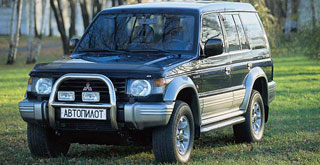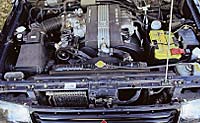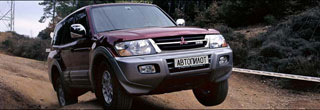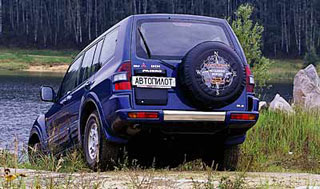Test drive Mitsubishi Pajero (Montero, Shogun) LWB 2000 - 2003 SUV
$13000
 When the hunt is more than captivity and I want to own a real and prestigious jeep, you can pay attention to the second generation of Mitsubishi Pajero.
When the hunt is more than captivity and I want to own a real and prestigious jeep, you can pay attention to the second generation of Mitsubishi Pajero. In this form, he appeared in June 1991 and was produced in June 1997. Pajero was made in three types of body: a short -term three -door Metal Top, a long -standing five -door Wagon and a short -knit Canvas Top with a removable fabric top. We will dwell on all -metal bodies - the most common in the Russian market. From 1991 to 1994, these machines were equipped with 2.5-liter 4-cylinder turbodiesels and 3-liter V-shaped gasoline sixes. Since 1994, a new 2.8-liter turbodiesel has appeared, as well as a 3.5-liter gasoline engine. There was also a 4-cylinder 2.4-liter gasoline engine, but it was not supplied to Europe at all.
A distinctive feature of all Pajero-II was the new Super Select transmission with 4 drive modes: the rear, constant full, full with the locking of the center differential and complete lowered.
 Whose will you be? With the clarification of this particular circumstances, the consultants advise you to start acquaintance with the attracted car. It should be a European or, in extreme cases, an American-montero. They are not advised to contact Arabs-Yuzhans. Systems of launch, engine control, cooling and much more not driven for our conditions.
Whose will you be? With the clarification of this particular circumstances, the consultants advise you to start acquaintance with the attracted car. It should be a European or, in extreme cases, an American-montero. They are not advised to contact Arabs-Yuzhans. Systems of launch, engine control, cooling and much more not driven for our conditions. The specifics of Pajero in Russia is that in the mid-90s they were specifically popular among real boys and boys. And in the case of Pajero, one of the leaders was one of the leaders. Many cars living in Russia since then may be muddy. Let's start checking from the state and customs databases, compliance with the passport data of the machine and its real state. Pajero has two groups of numbers, VIN and model code. The entire equipment of the car is encrypted in them - from the body, such as the engine and the checkpoint up to the decoration of the cabin and the supply market. Having deciphered this information from an official dealer, you will immediately find out whose he will be. Something can be found out at once and yourself-the third letter B in VIN and the last number 12 in the model code means that the machine was delivered to Europe. Everything should match. The model code is on the nameplate on the inside of the hood and must be present (explanations of the type of hood are not changed). VIN is knocked out on the frame, in the arch of the right rear wheel and duplicated on the right on the motor shield. It is very important to read it precisely on the frame, otherwise you will do a huge headache in communicating with the traffic police.
 Super selection. So, there is no doubt. Let's move on to the technique. A considerable money is asked for Pajero because he is a jeep. This is what we start with this. The icon with the image of the wheels on the dashboard should be slightly fit and caught up constantly. If she continues to wink at you, then perhaps it hints that the front bridge has not connected. We hang out the front wheel, turn on the ignition and put the lever of the distribution to position 4H. Do you manage to crank the wheel? Congratulations - repairing the connection mechanism will require $ 150 to $ 500. We are going on. The voiced characteristic blows from the handout are expensive - this stretched chain hits the case, the overhead is inevitable - almost $ 1 thousand ($ 400 per chain and $ 600 for work). The presence or absence of a differential of a limited sliding LSD in the rear bridge is found out on the model code or in the direction of rotation of the rear wheels in a hanged state. They should rotate in one direction. And if, twisting on the spot, the wheels from afar and clicks, know: at a minimum you will find the replacement of improperly flooded transmission oil, and to the maximum - replacing the LSD mechanism, more than $ 1,500. And the crunch of Shrus'ov will inform you about the prospect to part with almost $ 1200. Forced blocking, if any, is difficult to check. If the corresponding bulb on the icon does not light up, then this can mean anything - from the repair of the electrical wiring of the blocking pneumatic compressor to its replacement. Let's see how the car is going on all -wheel drive. Tangible jerks, points, vibrations, etc., causing decent discomfort, can have many reasons, but the most unpleasant - the mismatch of the bridges to this car. Simply put, rearranged from another version. It is precisely determined only in service conditions. And the vibrations and knocks when turning on, turning off the clutch on the version with the mechanics, can mean the production of guide a squeezer bearing-there is a replacement of the crankcase (about $ 650). As well as the fuzzy operation of the machine gun selector and the inconsistency of its position to the real regime means that the oxide from salt and the mud block selection of modes on the checkpoint itself - the replacement costs $ 250.
Super selection. So, there is no doubt. Let's move on to the technique. A considerable money is asked for Pajero because he is a jeep. This is what we start with this. The icon with the image of the wheels on the dashboard should be slightly fit and caught up constantly. If she continues to wink at you, then perhaps it hints that the front bridge has not connected. We hang out the front wheel, turn on the ignition and put the lever of the distribution to position 4H. Do you manage to crank the wheel? Congratulations - repairing the connection mechanism will require $ 150 to $ 500. We are going on. The voiced characteristic blows from the handout are expensive - this stretched chain hits the case, the overhead is inevitable - almost $ 1 thousand ($ 400 per chain and $ 600 for work). The presence or absence of a differential of a limited sliding LSD in the rear bridge is found out on the model code or in the direction of rotation of the rear wheels in a hanged state. They should rotate in one direction. And if, twisting on the spot, the wheels from afar and clicks, know: at a minimum you will find the replacement of improperly flooded transmission oil, and to the maximum - replacing the LSD mechanism, more than $ 1,500. And the crunch of Shrus'ov will inform you about the prospect to part with almost $ 1200. Forced blocking, if any, is difficult to check. If the corresponding bulb on the icon does not light up, then this can mean anything - from the repair of the electrical wiring of the blocking pneumatic compressor to its replacement. Let's see how the car is going on all -wheel drive. Tangible jerks, points, vibrations, etc., causing decent discomfort, can have many reasons, but the most unpleasant - the mismatch of the bridges to this car. Simply put, rearranged from another version. It is precisely determined only in service conditions. And the vibrations and knocks when turning on, turning off the clutch on the version with the mechanics, can mean the production of guide a squeezer bearing-there is a replacement of the crankcase (about $ 650). As well as the fuzzy operation of the machine gun selector and the inconsistency of its position to the real regime means that the oxide from salt and the mud block selection of modes on the checkpoint itself - the replacement costs $ 250.  The patient is rather alive. Any deviation from normal work, knocks, vibrations, jerks during acceleration should be the reason for a visit to specialists. There can be anything - from a simple replacement of candles to the bulkhead of the head on gasoline engines (up to $ 1,500). Do not flatter yourself that you can get rid of their replacement from the knock of hydraulic compensators. On cars with large, for 100 thousand km, mileage often destroy the valves themselves, they begin to knock. This is treated, alas, only by bulkhead. On the diesel, leaks of all kinds, failures, lack of traction, poor speaker, thick black smoke from the exhaust pipe and a particularly characteristic metal knock in the cylinders (some of the nozzles) should especially alert-this means a dying state of fuel and energy unit. The prices for the new are simply secret, but repair is also possible. It will cost a maximum of $ 500-600. And the efforts of diesel fuel in the area of \u200b\u200bnozzles of sprayers will report that they are being retired. Their wires will cost about $ 100 apiece there. It is also important to check the system of warming up the fuel pump. After starting, it briefly increases the engine speed and then lowers them to a normal level. And be sure to check the performance of shock absorbers with variable rigidity, if any. The mechanisms installed on them, when switching the modes, emit characteristic buzzing. Silence will cost $ 330 for each. And the unequal number of rulings of the steering wheel to the left or right from the average position will say about the violation of the geometry of the suspension. And this is an order of magnitude more expensive. Here and decide whether to continue the detailed examination with specialists or to refuse this machine. By the way, rolling around, do not forget about the work of the brakes. Vibrations and/or departments speak of curves and unhealthy calipers. Only the discs will cost $ 137 for the front and $ 257 for the rear. And non -working or prematurely, with the smallest braking, the triggering ABS should generally become a reason for a serious conversation with the seller. Here, again, options are possible, from cleaning the rotor-groove and repairing the wiring to replacing sensors. Which the? It costs only $ 583.
The patient is rather alive. Any deviation from normal work, knocks, vibrations, jerks during acceleration should be the reason for a visit to specialists. There can be anything - from a simple replacement of candles to the bulkhead of the head on gasoline engines (up to $ 1,500). Do not flatter yourself that you can get rid of their replacement from the knock of hydraulic compensators. On cars with large, for 100 thousand km, mileage often destroy the valves themselves, they begin to knock. This is treated, alas, only by bulkhead. On the diesel, leaks of all kinds, failures, lack of traction, poor speaker, thick black smoke from the exhaust pipe and a particularly characteristic metal knock in the cylinders (some of the nozzles) should especially alert-this means a dying state of fuel and energy unit. The prices for the new are simply secret, but repair is also possible. It will cost a maximum of $ 500-600. And the efforts of diesel fuel in the area of \u200b\u200bnozzles of sprayers will report that they are being retired. Their wires will cost about $ 100 apiece there. It is also important to check the system of warming up the fuel pump. After starting, it briefly increases the engine speed and then lowers them to a normal level. And be sure to check the performance of shock absorbers with variable rigidity, if any. The mechanisms installed on them, when switching the modes, emit characteristic buzzing. Silence will cost $ 330 for each. And the unequal number of rulings of the steering wheel to the left or right from the average position will say about the violation of the geometry of the suspension. And this is an order of magnitude more expensive. Here and decide whether to continue the detailed examination with specialists or to refuse this machine. By the way, rolling around, do not forget about the work of the brakes. Vibrations and/or departments speak of curves and unhealthy calipers. Only the discs will cost $ 137 for the front and $ 257 for the rear. And non -working or prematurely, with the smallest braking, the triggering ABS should generally become a reason for a serious conversation with the seller. Here, again, options are possible, from cleaning the rotor-groove and repairing the wiring to replacing sensors. Which the? It costs only $ 583. For dessert we will examine the salon and check the operation of the equipment. If the former owner loved to shoot bunnies or saigas, then the hatch is most likely skewed. Restoration will shed light on $ 150-300. Turning the ignition key, check the operation of all control bulbs. Cruise control should be checked both in statics when the ignition is turned on (the light should light up) and in motion.
Of course, all of the above horror stories are unlikely to meet immediately on the same car. The matter is different. A good SUV is worth a lot. And the used one requires special attention and responsibility when choosing and buying. And the savings in pre -cure diagnostics in specialists can result in a financial crisis. One clarification is needed here: practice shows that in Russia Pajero the release of the mid-90s in good condition costs at least $ 13-14 thousand. And since you are offered significantly cheaper, then the difference will pay the service for the aforementioned including. And the costs of spare parts and work, if desired, due to non-original spare parts and non-authorized, but specializing in such technical centers, can be reduced by one and a half to two times.
Text Andrey Timofeev, photo Alexey Kudenko
We thank for consultations for the technical center Rolf Center, (095) 940-1942.
Mitsubishi Pajero 2.5TDI/2.8TDI/3.0/3.5
Working volume (cubic meter) 2477/2835/2972/3497
Power (L.S.) 99/125/179/208
Maximum speed (km/h) 147/150/165/185
Acceleration to 100 km/h (sec.) 16.2/16.1/12.5/10.5
Fuel consumption (l per 100 km)
city 4/13.9/15.7/17.8*
highway 9/9.4/10.4/11
Prices for A/M Pajero/Montero in Moscow (for October 2001)
Year of release price
1992 $ 8-10.5 thousand
1993 $ 8.7-12.5 thousand
1994 $ 9.5-14 thousand.
1995 $ 9-16 thousand.
1996 $ 14.5-20 thousand.
1997 $ 12.8-19 thousand.
Dealership prices for consumables and some spare parts
Oil filter $ 20
Air filter $ 30
Fuel filter $ 50
Spark plugs (pcs.) $ 5.2
Enjoying candle (pcs.) $ 40-70
Brake pads, per./Ass. $ 120/120
Brake discs, per. $ 150
Hydracks (pcs.) $ 23
Pipe exhaust system $ 350
Wind glass (set) $ 270-600
Source: "Autopilot"
Mitsubishi Pajero (Montero, Shogun) LWB 2000 - 2003
Mitsubishi Pajero (Montero, Shogun) LWB 2000 - 2003
Mitsubishi Pajero Faults 5 doors: Detailed information| Pajero (Montero, Shogun) LWB 2000 - 2003 | |
|---|---|
| Engine |  |
| Transmission |  |
| Control system and suspension |  |
| Brake system |  |
| Air heating and air conditioning |  |
| Launch and charging system |  |
| Electric components and so on |  |
| Corrosion body stability |








